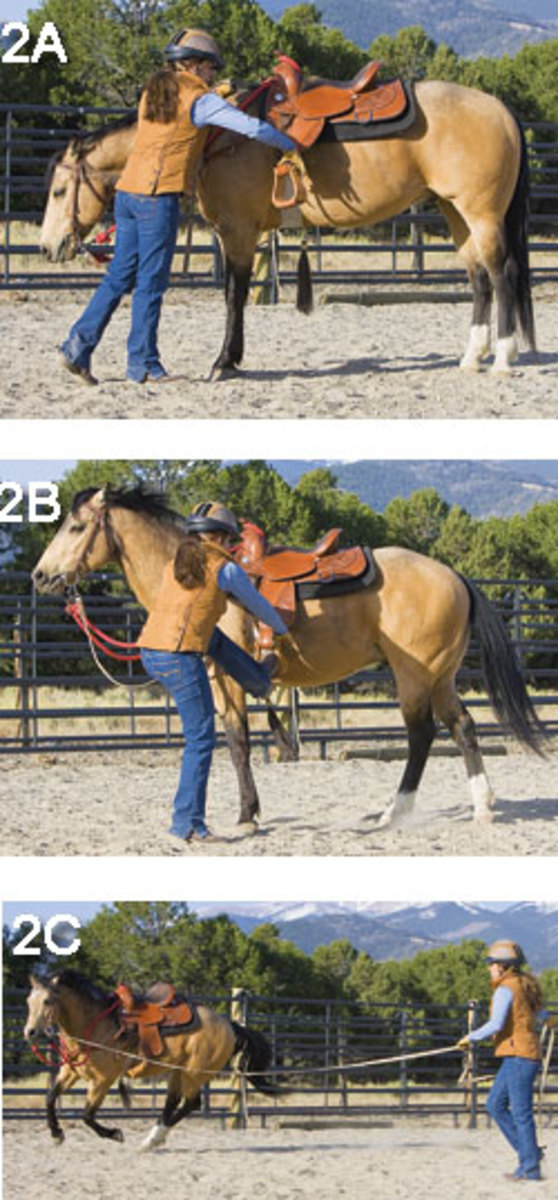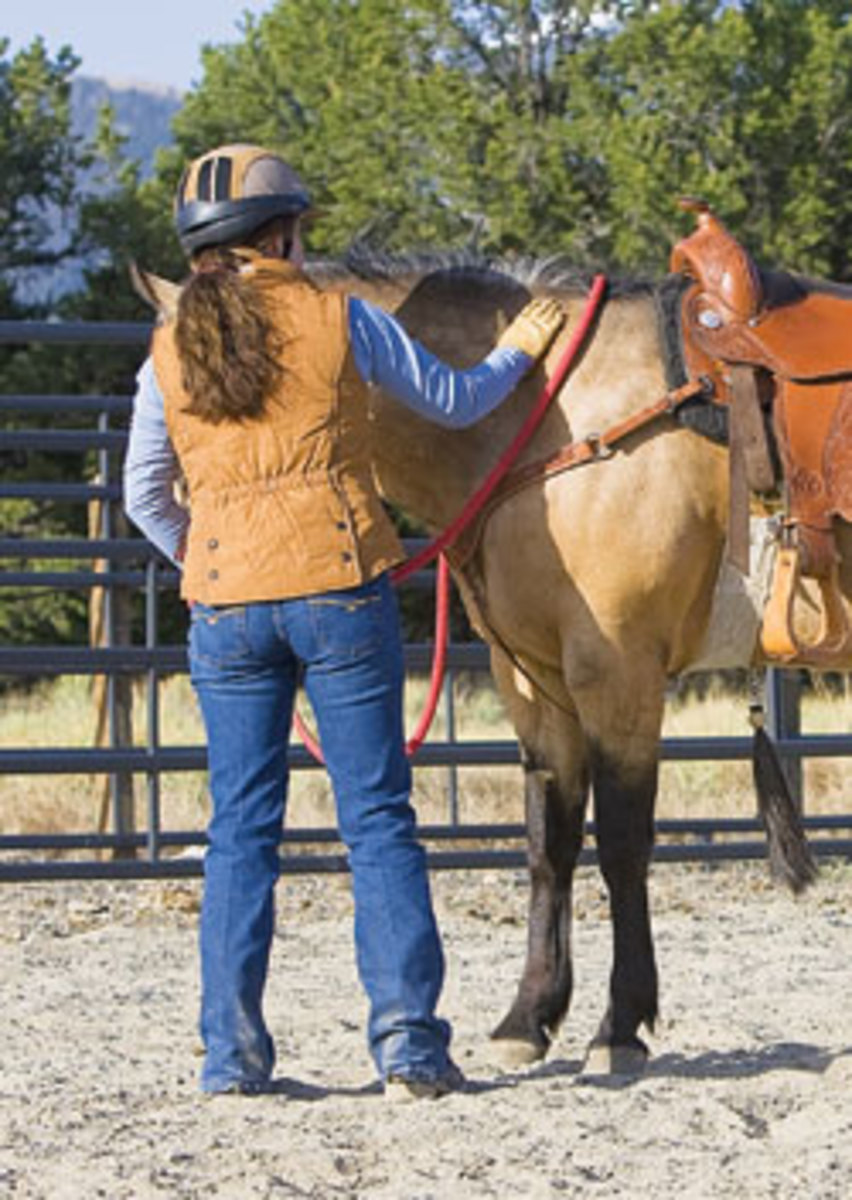
If your horse walks off as you’re trying to get on, chances are, you’ve taught him this frustrating behavior. If you’ve ever allowed your horse to start walking without a cue and as soon as your pockets hit the saddle, you’ve taught him that the cue to walk is you sitting on his back.
As the habit continues, your horse trains himself to walk as soon as you put a foot in the stirrup, then as soon as you approach with reins in your hand. While he thinks he’s perfecting a cue, you get frustrated and feel unsafe when your horse walks away when your foot is stuck in the stirrup.
To fix this mounting-in-motion problem, top clinician/trainer Julie Goodnight will teach you how to retrain your horse to stand still for mounting. You’ll make your horse think that walking off means work, while standing still is easy and worthy of praise. You’ll also remind him that you dictate his every step. If you don’t cue him to move, even after you mount, he should stand still and wait for orders from you, his herd leader.
Teaching your horse to stand still for mounting will boost your safety on the trail and your ability to trust your horse. If you need to mount or dismount in open spaces, your horse may think that your presence and riding gear means that it’s time to take off at full speed; and if there’s precarious footing, his unauthorized steps might cause him or you to slip.
It’s time to correct your horse’s poor manners and establish yourself as your horse’s leader. As his leader, only you decide when it’s time to move. You make the decisions for your herd of two.
Goodnight says she expects all of her horses to stand still on a loose rein for mounting and until a rider gives a cue to move. A horse that stands still while his rider steps up and waits patiently for a cue to walk off shows that he has manners and knows his place in the herd. If he moves on his own, he doesn’t respect his place in the herd and you as his leader.
Exercise Prep
Natural-horsemanship lesson: Teach your horse to stand still as you mount up.

Why you need it on the trail: When you mount up in the open, it’s especially important for your horse to patiently wait for your seat to land in the saddle, for you to get situated, and for a go-forward cue before he takes a step.
What you’ll do: You’ll prepare your horse for a ride in an enclosed arena, secure the reins, and attach a longe line to his bit. As you mount in slow motion, you’ll watch for your horse to take a step. As soon as he does, you’ll make him work by longeing him so that he’ll associate taking a step with more work. Once your horse is standing still as you step toward him, you’ll praise him for his obedience. Finally, you’ll test his standing-still skills by mounting up on the trail.
What you’ll need: An enclosed arena or large round pen; a longe line with a snap; a bridle with a snaffle bit and split or rope reins; your usual saddle and saddle pad.
Step #1. Prepare Your Horse
Outfit your horse in the tack listed above. Clip the longe line to the ring on the left side of the snaffle bit (Photo 1A). Neatly coil the excess longe line, and hold it in your left hand. Place the reins over his head or around his neck and secure them to the saddle so they won’t come loose and trip your horse as you work (Photo 1B).
Stand your horse square, so his weight is evenly distributed on all four feet, and no leg is cocked. Then you won’t inadvertently force him to move for balance when you mount. Note: If he isn’t standing square when you mount and must take a step for balance, don’t penalize him.

Step #2. Mount Up Slowly
Approach your horse to mount up, but do so in ultra-slow motion (Photo 2A). Pay attention to where you are in the mounting process when your horse begins to walk without being cued. You may find that simply walking to your horse’s side prompts him to move. Or, you may find that you can twist your stirrup and raise your leg – or even get your foot in the stirrup – before he takes a step.
As you test your horse, make sure you don’t prevent him from moving. He’ll need to make the mistake before you can correct it (Photo 2B). The moment your horse takes a step, it’s time to make him work.
Correction technique: The moment your horse takes a step, take your foot out of the stirrup, back up, and feed some longe line from the coil. As soon as you’re in a safe spot, raise your right arm, slap it on your leg, make a “swoosh” sound, stomp your feet, and make your horse move (Photo 2C). Your goal is to teach your horse that walking off means work.
Be firm so your horse associates his movement with having to work hard. Standing still will now be easy and moving will be hard. Ask him to lope 5 to 10 laps around the longe circle so he understands he has to work. Work him long enough so that he wants to stop. You’ll see him breathing hard and looking in to you for a stop cue.
When your horse wants to stop, say “whoa,” and allow him to rest for a moment. Then square him, and repeat the mounting process. Repeat this process until he stands still as you place your foot in the stirrup.
Important: Your horse will learn the lesson quickly if your correction is well-timed. Horses associate a behavior with the consequence if a correction comes within three seconds of the original act; the quicker, the better.
Simply put, if you’re quick and put your horse to work the instant he steps off, he may learn his lesson on the first try. If you wait too long before asking him to work, he may not associate the correction with his action. Or, worse, think he was supposed to walk off.

Step #3. Praise Him
Once your horse will stand still as you get a foot in the stirrup, you’ll change your training plan. That is, you’ll begin praising him for his new stand-still behavior.
When your horse stands still while you step into the stirrup, resist the urge to get all the way on. Instead, step back down, and praise him petting him on the neck. Mount and dismount until he stands still every time you put your foot in the stirrup. If he takes a step, make sure you’re holding the longe line so you can initiate the correction technique outlined in Step #2 when necessary.
Step #4. Mount Up
Once your horse will stand still when you put a foot in the stirrup, lift your right foot completely off the ground. Practice stepping up, then placing your right foot back down on the ground. If your horse takes a step, initiate the correction technique outlined in Step #2. If he stands still, step off, and praise him.
When your horse stands still as you step up, fully mount. Once you swing your leg over his back, use rein pressure to stop him, if necessary. But up until that point, he should willingly stand still on a loose rein.
When your horse stands still as you mount and dismount, test his stay-put ability in an open area. As you do, keep the longe line attached in case you need to correct him. Keep in mind that his training is location specific. He may behave perfectly in the arena, but need a refresher course when you’re in an open area






